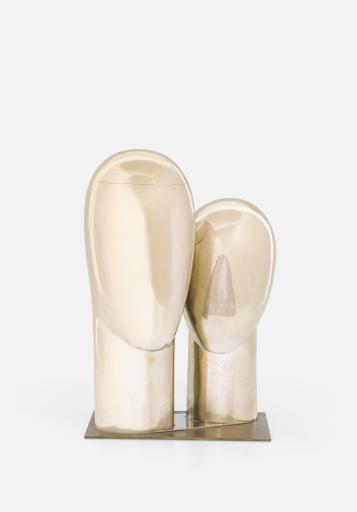The exquisite works of art, collected over decades of collecting, complement the Hagenauer holdings of the Leopold Museum, which now has the world’s most extensive and important collection of Franz Hagenauer (1906-1986), the “designer among sculptors”. “His heads made of beaten metal, created from the late 1930s onwards and often reduced to mere ovoids, are among the most radical modernist advances in Austrian art of the interwar period,” explains Hans-Peter Wipplinger, director of the Leopold Museum. In 2022, the Leopold Museum had already dedicated a comprehensive, long overdue retrospective to the artist with more than 170 exhibits. The majority of the loans came from Monika and Erich Breinsberg. Selected heads and torsos of Franz Hagenauer are now on permanent display From Expressionism to New Objectivity seen on level 0.
“The rich treasure trove of sculptures and design objects that Erich Breinsberg has collected with great passion over the course of over four decades is not only secured in its entirety in the Leopold Museum, but is also made permanently accessible to the public and to art-scientific researchers. This extremely generous donation represents an extraordinary act of patronage from the Breinsberg family and is considered one of the most important donations in the recent history of the Leopold Museum, which fills us with deep gratitude,” emphasizes Hans-Peter Wipplinger.
“Franz Hagenauer was a co-creator of a fascinating era of modernity. His unique works should continue to bring joy to many people in the future. “It’s a good feeling to entrust the Leopold Museum with this further journey,” says Erich Breinsberg.
“Give form to life”
Franz Hagenauer studied at the Vienna School of Applied Arts under Franz Čižek and leading artists such as the important architect and designer Josef Hoffmann and the sculptor Anton Hanak, from whom Hagenauer received a sound education. This culminated in his participation as a 19-year-old International Exhibition of Modern Decorative and Industrial Arts 1925 in Paris. The encounter with the contemporary avant-garde inspired him significantly. His embossed metal sculptures were influenced by Art Deco, Art African, Neoclassicism and Bauhaus. “Giving form to life” was Franz Hagenauer’s declared goal.
Looking beyond the regional horizon
His work reflects the desire for innovation and high quality standards of Viennese handicrafts around 1900. As a young man, the metal artist studied with Dagobert Peche, one of the protagonists of the Wiener Werkstätte, whose designs can currently be seen in the Backhausen exhibition at the Leopold Museum (until March 9, 2025).
Hans-Peter Wipplinger points to the international dimension of Franz Hagenauer’s work, who was “always driven by a desire to create without any purpose and looked far beyond the regional horizon as early as the 1920s. In early Parisian modernism, neoclassicism, Bauhaus and Art Deco, he found diverse opportunities to formulate artistic ideas that ultimately aimed at an absolute purification of form.”
Over six decades, Hagenauer created a fascinating range of works of art. Participation in the Triennale in Milan in 1930 and the Biennale in Venice in 1934 were early stages of his success. After his brother’s death, he ran the workshop in Vienna-Neubau founded by his father Carl Hagenauer in 1956, taught at the Academy of Applied Arts from 1962 and exported his work to the USA through the Art Deco revival in the 1970s. The MAK (1971) and the Leopold Museum (2022) dedicated extensive museum presentations to his experimentally rich oeuvre.
Two important Franz Hagenauer collections combined
In addition to Leopold Museum founder Rudolf Leopold, who also distinguished himself as a collector of Hagenauer’s works, it is particularly the Breinsberg family’s credit for having put together the most important collection of his sculptures and design objects over four decades. The donation is the result of Erich Breinsberg’s consideration of integrating this world’s largest and most important holding of Franz Hagenauer’s works into the Leopold Museum and thus creating the most outstanding international Franz Hagenauer collection in terms of substance from both collections in one fell swoop. Thanks to the donation from Erich and Monika Breinsberg, these two important Hagenauer collections have now been brought together in the Leopold Museum.
The publication about the donation
Made possible by the support of the Liewers car dealership, a new publication based on the catalog accompanying the exhibition was created following the retrospective in the Leopold Museum. Through a new design concept and numerous content additions to the exhibition catalog at the time, the volume brings together the entire artistic range of Hagenauer’s work and provides the basis for honoring his significant life’s work in the context of international presentations. The bilingual catalog (German/English) of Franz Hagenauer’s work was completely revised in view of the donation and is now available in this expanded edition under the title Franz Hagenauer. A singular position of modernity. The Breinsberg Collection before, edited by Hans-Peter Wipplinger, with contributions by Erich Breinsberg, Maria-Luise Jesch, Marco Antonio Ricci, Ivan Ristić and a foreword by Hans-Peter Wipplinger. The 304-page publication with 169 color illustrations, some full-page, and 53 black-and-white illustrations, is in Published by the bookstore Walther and Franz König, Cologne. The book is available in the Leopold Museum Shop for a retail price of Euro 24.90
